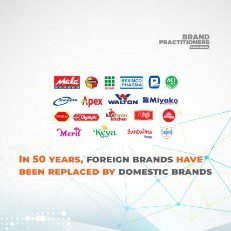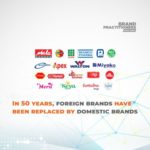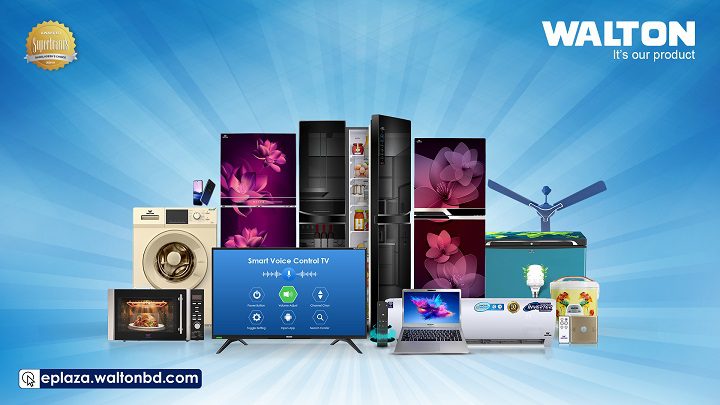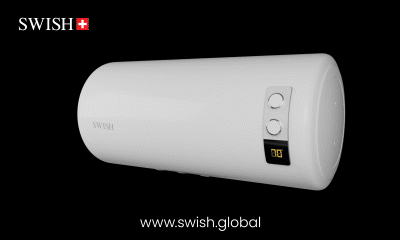 In 50 years, foreign brands have been replaced by domestic brands
In 50 years, foreign brands have been replaced by domestic brands
There are at least a dozen local brands in present-day Bangladesh that have either surpassed the foreign competitors or put up stiff competition.
In pre-independence Bangladesh, business and Bengali meant some small retailers and traders of agricultural products.
Building a local brand was unimaginable then. However, with the rise of big entrepreneurs in independent Bangladesh, the landscape has changed. Local entrepreneurs have gradually dominated the economy by building a prosperous private sector.
Hundreds of local brands have won the trust of consumers for their welfare. Many of the top brands of the present time are local.
Half of the top 50 Brands are Local
According to a 2016 survey by Canter Worldpanel, the world’s leading market research organization, half of the top 50 brands in Bangladesh are local. This strong position of the local brand points to the rise of local ‘soft assets’ in the economy.
There are at least a dozen local brands in present-day Bangladesh that have either surpassed the foreign competitors or put up stiff competition.
Local brands are also dominating the pharmaceuticals, food, salt, cement, and steel markets.
Research Director of the Policy Research Institute. Mohammad Abdur Razzak said that over time, Bangladeshi brands have narrowed the gap with foreign brands. It has played an important role in the country’s GDP. He also said that local brands have contributed to the development of Bangladesh as a role model for development in the international arena.
According to Abdur Razzak, the rapid economic transformation of Bangladesh has been facilitated by the emergence of a strong private sector.
“The comparatively more developed private sector has bridged the gap between Bangladesh and other least developed countries and many lower and lower-middle-income countries,” he said.
He further said that the ratio of production to GDP of Bangladesh is quite large – about 20 percent. That’s double the LDC group’s average — even higher than in India, Pakistan, and Sri Lanka. Thanks to this ratio, the brands of this country have been able to develop.
Freedom: Foundation Formation
The number of Bengali-owned private industries was negligible during the Pakistan period. At that time, the Mala Group of Anwar Group in Dhaka showed with its finger in the eye that Bengalis can also improve in big business.
Independence-North Bangladesh focuses only on basic needs, mainly food. All the industries left behind by the West Pakistanis were taken over by the state.
A handful of local entrepreneurs — who have previous business experience — take the lead in their business endeavors. Even then full privatization has not started.
Bangladeshi entrepreneurs started their journey by taking charge of existing brands like Nabisco Biscuits and Tibetan Ball Soap.
They make a big difference by creating their own brand.
Over time, they have broken the monopoly of foreign brands. Bangladeshi brands are now dominating the market in many cases. In some sectors, foreign brands have found it profitable to move away from the competitive market.
Compete First, then Move on
Due to its ample human resources, Bangladesh was mainly focused on the export of global brands in the categories of garments, leather goods, and some more.
Then the focus shifted to the local market to take advantage of the rapidly growing consumer segment and their growing purchasing power.
The legendary rise of the local pharmaceuticals industry began in the 1960s with the introduction of import substitution policy. In the 1980s, a small pharmaceutical company based in Pabna set up a factory near Dhaka.
Beximco is one of the earliest entrepreneurs of independent Bangladesh. The company enters the pharmaceutical industry and achieves success through dedication and excellence.
Before the new millennium, the pharma giant Pfizer of the United States sold its business to a local company and left the market. Currently, it has become Renata. GlaxoSmithKline, a leading vaccine company, closed its pharmaceutical factory in Chittagong in 2016 due to the rise of world-class local competitors such as vaccine inceptors.
Now Bangladeshi generic brands are present everywhere from over-the-counter (medicines that do not require a prescription to buy) to anti-cancer drugs.
For decades, the shoe was another name for Bangladeshi consumers. There was no local brand to compete with Butter.
Apex Footwear, a local enterprise, started its journey in 1990 as a contract manufacturer of Japanese and Italian brands. After a long period of shoe exports, the company turned its attention to the local market in the early 2010s.
It took less than a decade for Apex to surpass the century-old global brand Bata in the Bangladeshi market.
Meanwhile, over the past decade, another century-old foreign brand, Singer, has lost control of the fridge and television empire to local brand Walton.
According to a 2021 research report by UCB Asset Management, Walton now owns 72% of the refrigerator market. And Singer occupies only 12 percent of the market. In addition, Jamuna, Minister, and many other local brands have also entered the Singer market.
Singer also dominated the television market. But Walton is now far ahead of the rest with a market share of 26 percent, and Singer is in second place with an 11 percent market share.
Local brands have not yet surpassed foreign brands in the categories of air conditioners, washing machines, and various kitchen appliances. However, it will not take long for these markets to dominate. Walton is now investing heavily in research and development and marketing with a view to the global market.
Bangladeshi kitchen appliance brand Miyako is second only to Samsung with a 21 percent market share.
Walton began its journey as a low-cost market competitor in the late 2000s. The company’s Chief of Business Operations, Sohail Runner, has helped the company grow and market its products in line with the beliefs, supportive government policies and the needs and capabilities of local consumers, and has now helped them pursue their global dreams.
For decades, Bangladeshis have been riding bicycles of Indian heroes and Chinese phoenixes. But now world-class Bangladeshi exporters like Duronto of Meghna and RFL are occupying a large part of the local bicycle market and surpassing foreign brands.
The Olympics began in the 1990s as a local confectionery brand. At that time, the market was dominated by local and imported foreign brands.
After nearly three decades, the Olympics have now emerged as the market’s leading organization by a wide margin.
Bangkok-based Frozen Ready Mill Giant CP entered Bangladesh in the late 1990s and expanded its retail outlets to the market in the 2010s. But strong local competitor Kazi Farms Kitchen has apparently outperformed the CP market in recent years.
In their busy lives, Bangladeshi consumers have now chosen Randhuni and Pran as their first choice brands for ready-made spice blends.
Local brands ACI Salt and ACI Aerosol top the respective markets.
In the case of tea, local brand Ispahani has taken the top spot by beating foreign brands like Lipton and Tetley.
Still where Foreign Brands Dominate
In 2016, citing Kantar Worldpanel Market Intelligence, a BBC report said that the top nine brands in the Bangladeshi market were multinational brands. The tenth place was occupied by the Tibetan ball soap. Tibet was the leader of all Bangladeshi brands in terms of brand strength and value.
The three most powerful brands are Unilever’s Sunsilk Shampoo, Lux Soap, and Rin Detergent.
The sudden rise and fall of the local ‘Halal Soap’ aromatics, the local market soap Merrill and Keya, or the premium soap Sandalina have the eye of a large group of Bangladeshi consumers.
Brands, including British American Tobacco, Berger, and Marico, still dominate the tobacco, dyes, and hair cosmetics markets. However, local brands are also competing in these markets.
Foreign hygiene product brands Dettol and Savlon have been dominating the market for a long time. But local brands like Square’s Sepnil continue to compete with them.
MA Razzak Khan, Vice President, FBCCI, said the post-independence business environment and facilities have helped in the development of local brands. Made-in-Bangladesh is now accelerating this development.
Bangladeshi corporates now have the necessary financing capacity and value proposition. There is also the brain to keep a brand competitive and capable.
MA Razzak believes that in the coming years, a large number of domestic brands will become stronger at home and abroad.
In many industries, including the garment sector, the market is still not very much in a way with the brand. However, the situation is changing rapidly. Due to the lack of presence of global lifestyle brands in the country, local brands like Arang, Yellow and Sara are investing in this sector.
Maybe one day this will turn the Bangladeshi market into a new battleground for retail brands.












